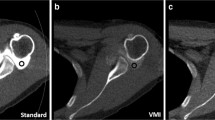Abstract
Objective
To study the clinical application of dual-energy CT (DECT) in the knee ligaments.
Methods
Twelve cases (24 knees) were scanned using dual-energy CT for the knee. Two- and three-dimensional images were used for display in all cases by means of multi-planar reformation (MPR) and volume rendering technique (VRT). All images were ranked by two radiologists according to the grade of knee ligament displayed, the definition of edge and attachment points of the knee ligament.
Results
The partial ligaments of 24 knees, such as the patellar ligament, fibular collateral ligament, anterior cruciate ligament (ACL) and posterior cruciate ligament (PCL) were clearly displayed; the tibial collateral ligament was not satisfactorily displayed. The transversal ligaments, such as lateral patellar retinaculum and medial patellar retinaculum, and the posterior ligament, such as oblique popliteal ligament could not be shown clearly.
Conclusion
The dual-energy CT is a new and valuable tool to qualitatively display the main ligaments of the knee.


Similar content being viewed by others
References
Achenbach S, Ropers D, Kuettner A et al (2006) Contrast-enhanced coronary artery visualization by dual-source computed tomography: initial experience. Eur J Radiol 57(3):331–335
Buckwalter KA (2006) CT arthrography. Clin Sports Med 25(4):899–915
Busse H, Thomas M, Seiwerts M et al (2008) In vivo glenohumeral analysis using 3D MRI models and a flexible software tool: feasibility and precision. J Magn Reson Imaging 27(1):162–170
Fayad LM, Rosenthal EH, Morrison WB et al (2008) Anterior cruciate ligament volume: analysis of gender differences. J Magn Reson Imaging 27(1):218–223
Flohr TG, MeCollough CH, Bruder H et al (2006) First performance evaluation of a dual-source CT (DSCT) system. Eur Radiol 16(2):256–268
Gold GE, Busse RF, Beehler C et al (2007) Isotropic MRI of the knee with 3D fast spin-echo extended echo-train acquisition (XETA): initial experience. Am J Roentgenol 188(5):1287–1293
Johnson TR, Krauss B, Sedlmair M et al (2007) Material differentiation by dual energy CT: initial experience. Eur Radiol 17(6):1510–1517
Van de Berg BC, Lecouvet FE, Poilvache P et al (2002) Spiral CT arthrography of the postoperative knee. Semin Musculoskelet Radiol 6(1):47–55
Van de Berg BC, Lecouvet FE, Maldague B et al (2004) MR appearance of cartilage defects of the knee: preliminary results of a spiral CT arthrography-guided analysis. Eur Radiol 14:208–214
Author information
Authors and Affiliations
Corresponding author
Rights and permissions
About this article
Cite this article
Sun, C., Miao, F., Wang, Xm. et al. An initial qualitative study of dual-energy CT in the knee ligaments. Surg Radiol Anat 30, 443–447 (2008). https://doi.org/10.1007/s00276-008-0349-y
Received:
Accepted:
Published:
Issue Date:
DOI: https://doi.org/10.1007/s00276-008-0349-y




